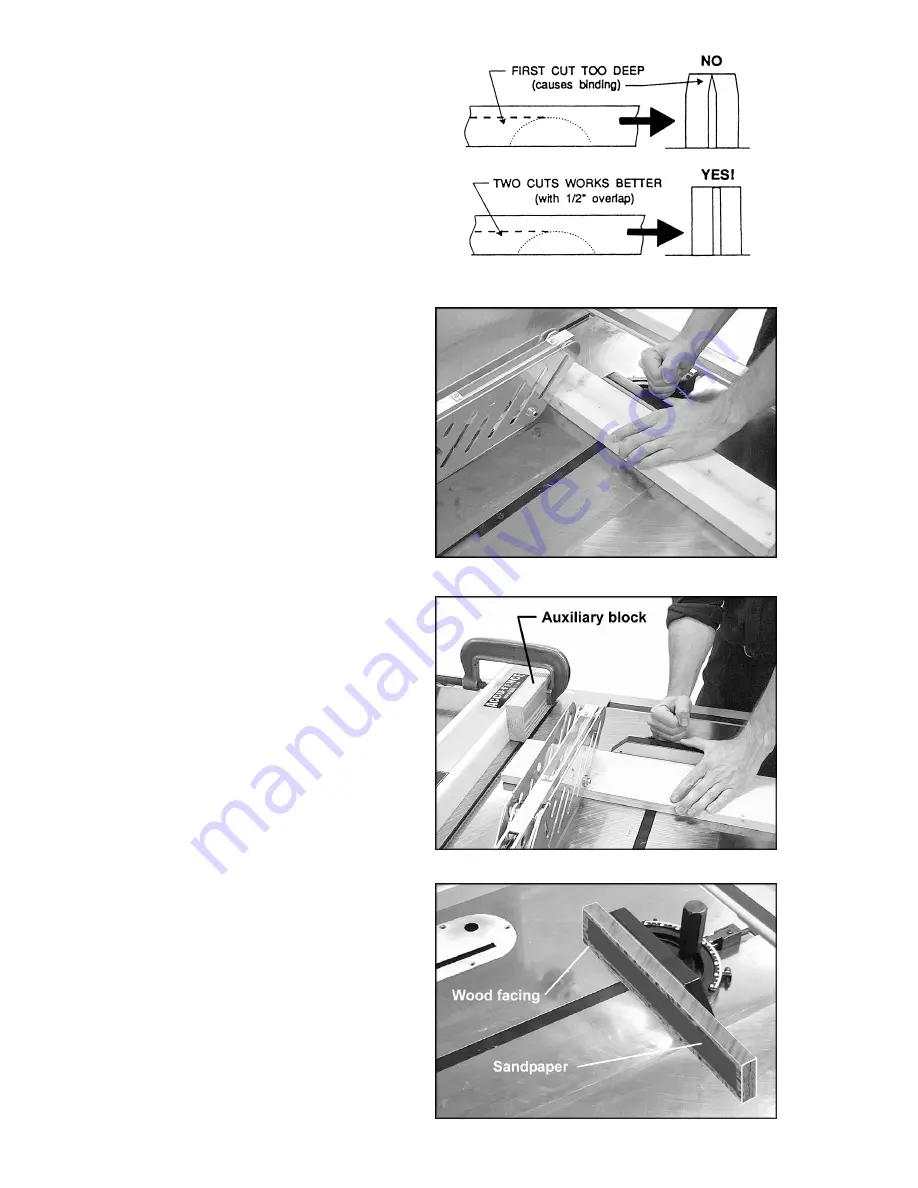
18
RESAWING
1.
Resawing is a ripping operation in which thick
boards are cut into thinner ones. Narrow boards up
to 3" can be resawed in one pass. Wider boards up
to 6" must be resawed in two passes.
2.
In resawing wider boards, adjust the blade height
so as to overlap the two cuts by 1/2" as shown in
Figure 28. Too deep a first cut can result in binding
and possible kickbacks on the second cut. Always
use the same side of the board against the fence for
both cuts.
CROSSCUTTING
1.
Crosscutting is where the workpiece is fed cross
grain into the saw blade using the mitre gauge to sup-
port and position the workpiece. See Figure 29.
Crosscutting should never be done freehand nor
should the fence be used as an end stop unless an
auxiliary block is clamped to the front of the blade
area such that the cutoff piece comes free of the block
before cutting starts. See Figure 30. Length stops
should not be used on the free end of the workpiece
in the cutoff area.
2.
Do not crosscut workpieces shorter than 6". Be-
fore starting a cut, be sure the mitre gauge is se-
curely clamped at the desired angle. Hold the
workpiece firmly against the table and back against
the miter gauge. Always use the saw guard and split-
ter and make sure the splitter is properly aligned.
2.
For 90 degree crosscutting, most operators pre-
fer to use the left-hand mitre gauge slot. When using
it in this position, hold the workpiece against the
gauge with the left hand and use the right hand to
advance the workpiece. When using the right hand
slot for mitre and compound crosscutting so that the
blade tilts away from the gauge, the hand positions
are reversed.
3.
When using the mitre gauge, the workpiece must
be held firmly and advanced smoothly at a slow rate.
If the workpiece is not held firmly, it can vibrate caus-
ing it to bind on the blade and dull the saw teeth.
4.
To improve the effectiveness of the mitre gauge
in crosscutting, some users mount an auxiliary
wooden extension face (with a glued-on strip of sand-
paper) to the mitre gauge as shown in Figure 31.
5.
Provide auxiliary support for any workpiece ex-
tending beyond the table top with a tendency to sag
and lift up off the table.
FIGURE 28
FIGURE 29
FIGURE 30
FIGURE 31
Summary of Contents for 72A
Page 21: ...21 FIGURE 38 FIGURE 37 ...
Page 27: ...27 Stand Assembly Model 72A ...
Page 29: ...29 ARBOR Model 72A ...
Page 31: ...31 Trunnion Model 72A ...
Page 33: ...33 Splitter Guard Assembly Model 72A ...
Page 34: ...34 ELECTRICAL SCHEMATIC Model 72A ...
Page 35: ...35 ELECTRICAL SCHEMATIC Model 72A ...
Page 36: ...36 ELECTRICAL SCHEMATIC Model 72A ...
Page 37: ...37 ...
Page 38: ...38 ...
















































